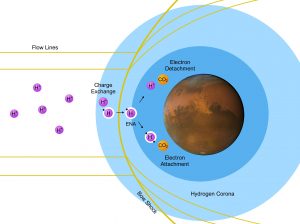Student: Sarah Henderson, graduate student in Physics, University of Iowa
Faculty Advisor: Jasper Halekas
Characterizing Energy Spectra of Precipitating Solar Wind H+ and H- in the Martian Atmosphere
 This research project focuses on how the solar wind interacts with the Martian atmosphere. As solar wind protons propagate towards Mars, they can interact with Mars’s extensive hydrogen corona through a process of charge exchange. These solar wind protons can obtain an electron from neutral atomic hydrogen in the corona, becoming fast energetic neutral atoms (ENAs) that maintain upstream solar wind velocity. These ENAs can bypass electromagnetic boundaries around the planet and penetrate to altitudes of ~130 km in the Martian atmosphere. Along their path of propagation, ENAs can undergo multiple charge-changing collisions as they interact with atmospheric neutrals (primarily CO2), resulting in observable beams of H+ and H– in the collisional atmosphere of Mars. The goal of this project is to characterize the properties of H– and H+ energy spectra in order to better understand charge exchange processes in the Martian atmosphere.
This research project focuses on how the solar wind interacts with the Martian atmosphere. As solar wind protons propagate towards Mars, they can interact with Mars’s extensive hydrogen corona through a process of charge exchange. These solar wind protons can obtain an electron from neutral atomic hydrogen in the corona, becoming fast energetic neutral atoms (ENAs) that maintain upstream solar wind velocity. These ENAs can bypass electromagnetic boundaries around the planet and penetrate to altitudes of ~130 km in the Martian atmosphere. Along their path of propagation, ENAs can undergo multiple charge-changing collisions as they interact with atmospheric neutrals (primarily CO2), resulting in observable beams of H+ and H– in the collisional atmosphere of Mars. The goal of this project is to characterize the properties of H– and H+ energy spectra in order to better understand charge exchange processes in the Martian atmosphere.
Thus far, we have implemented electron and ion data collected over seven years by the Solar Wind Electron Analyzer (SWEA) and Solar Wind Ion Analyzer (SWIA) onboard the Mars Atmosphere and Volatile EvolutioN (MAVEN) spacecraft and have found some interesting behaviors. We have observed seasonal increases in the H+ and H– fluxes congruent with perihelion and Mars’s dust season, in addition to a turnover in the ratio of the H+ and H– fluxes at a particular point within Mars’s atmosphere. We have also found that this seasonal enhancement is stronger for H+ and are seeking to better understand the underlying cause of this behavior by examining hydrogen column densities, solar radiation input, and bow shock position.